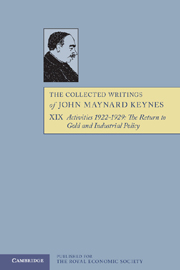Book contents
- Frontmatter
- Contents
- General introduction
- Editorial note
- PART I
- 1 FINANCE AND INVESTMENT 1922–1923
- 2 POPULATION, PROTECTION AND UNEMPLOYMENT
- 3 MONETARY REFORM AND UNEMPLOYMENT
- 4 THE RETURN TO GOLD AND FOREIGN LENDING
- 5 THE ECONOMIC CONSEQUENCES OF MR CHURCHILL
- PART II
- Appendix
- List of Documents Reproduced
- Index
4 - THE RETURN TO GOLD AND FOREIGN LENDING
from PART I
Published online by Cambridge University Press: 05 November 2012
- Frontmatter
- Contents
- General introduction
- Editorial note
- PART I
- 1 FINANCE AND INVESTMENT 1922–1923
- 2 POPULATION, PROTECTION AND UNEMPLOYMENT
- 3 MONETARY REFORM AND UNEMPLOYMENT
- 4 THE RETURN TO GOLD AND FOREIGN LENDING
- 5 THE ECONOMIC CONSEQUENCES OF MR CHURCHILL
- PART II
- Appendix
- List of Documents Reproduced
- Index
Summary
On 18 February 1924 the Prime Minister reassured the House of Commons that the Government was still guided as to future currency policy by the recommendations of the Cunliffe Committee, which included an eventual return to the gold standard at the pre-1914 parity. A fortnight later the Chancellor of the Exchequer, Philip Snowden, told the House that he appreciated the advantages of amalgamating the Treasury's wartime issue of currency notes with the Bank of England's note issue. As a result of these statements, after consultations within the Bank of England, Governor Norman suggested to the Chancellor that the Treasury set up a Committee to consider the amalgamation of the note issues and proceeded to suggest possible members. The Chancellor agreed and on 10 June the Treasury set up the Committee on the Currency and Bank of England Note Issues, ‘to consider whether the time has now come to amalgamate the Treasury Note Issue with the Bank of England Note Issue, and, if so, on what terms and conditions the amalgamation should be carried out’. The Committee's members were Sir Austen Chamberlain, a former Chancellor; Sir John Bradbury, formerly Permanent Secretary to the Treasury; Sir Otto Niemeyer, then in charge of the finance side of the Treasury; Gaspard Farrer, a banker; and Professor A. C. Pigou. At the time the Bank of England, the Treasury and members of the Committee all accepted that these terms of reference would allow a review of the problem of restoring the gold standard—especially as the Cunliffe Committee had recommended in 1918 that amalgamation of the note issues should follow a return to gold. […]
- Type
- Chapter
- Information
- The Collected Writings of John Maynard Keynes , pp. 238 - 356Publisher: Royal Economic SocietyPrint publication year: 1978



